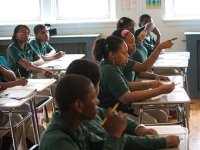5 Ways to Make Class Discussions More Exciting
Classroom discussions have been a staple of teaching forever, beginning with Socrates. I have taught using discussions, been a student in discussions, and observed other teachers' discussions thousands of times -- at least. Some have been boring, stifling or tedious enough to put me to sleep. Others have been so stimulating that I was sad to see them end. The difference between the two is obviously how interesting the topic is, but equally important is the level of student participation.
It's not enough for students to simply pay attention -- they need to be active participants to generate one of those great discussions that end far too quickly for both the teacher and students. The worst types of discussions are serial one-on-one talk between a student and teacher, leaving the rest of the class out of the process. Many students stop listening, begin to fade or disengage during this flawed procedure.
The best discussions keep everyone active, either by sharing or thinking. Even those students who rarely, if ever, contribute can still participate in other ways. Here are five of my favorite ways to design discussions in a dynamic and exciting manner.
1. Lightning Rounds
Just the name "lightning round" suggests energy. Make it even more dramatic by playing up the concept of speed, fun and excitement. Have your discussion questions prepared in advance so that you can ask them faster. Short-answer questions obviously work best for this technique. Students have 30 seconds (or a more appropriate time for your particular class) to answer. They can either answer or pass -- and no negativity is associated with passing. Ask the questions rapidly while growing the anticipation for each next question by imitating quiz show lightning rounds: "Are you ready for the next question? Here it comes." Ask the question before calling on a student so that all students must be ready to answer. The lightning round should take no longer than ten minutes, the approximate time that the energy begins to diminish.
2. Throw the Ball
When you ask a discussion question, call on students by letting them catch a ball. With young children, you can use a beach ball and roll it to students in a circle. Older students can catch a beach ball or nerf football. This way of calling on students can either be a lot of fun and full of energy, or it can be a disaster. Be sure to keep the throwing distance short enough to prevent chaos. Make the rules clear and stop if they are broken:
- Do not intercept the ball.
- Do not throw the ball at another student.
- Do not try to break anything in the class with the ball.
In spite of the potential danger with using a ball, I have seen this done with much success and great student involvement. A variation that is safer and fun for grades 1-3 is to pass a teddy bear to the student who will answer the next question.
3. Group Answers
Two commonly used discussion techniques can be put together to allow a discussion that involves everybody at the same time. One is to form small groups of about three students. When the teacher asks a discussion question, every group has a small discussion of its own to come up with an answer. Questions of complexity work best with this method. Add to that the use of small cards with each having a method of group identification. After allowing enough time for each group to develop its answer, randomly pick a card and let that group give their answer. You can pick more than one card for each question. When the answer has been completed, put the used card back in the deck, so that no group can relax and think that their turn is over.
4. Agreements
Keep each question going longer by engaging more students in the discussion. When the first student answers a question, ask another student if he or she agrees or disagrees with that answer. Then ask another student, and keep going until at least five students have participated in each question.
5. Questionnaires
A fun way to discuss famous people or fictional characters is to choose someone you are studying. Divide the class into groups of two or three, and have each group come up with three to five questions they would like to ask that person in an interview style. All group members should agree on all the questions. Each group then passes their questions to another group so that all groups have someone else's questions. Each group then has the task of answering one question in writing, with full agreement, and in a way they imagine the person might answer. Papers are changed until all questions are answered. Then encourage each group to share their questions and the answers they received.
One final point about good discussions: most students can easily hear the teacher, but depending on room arrangement, it can often be difficult for students to hear each other. Have you ever tried to follow a press conference on television when you could not hear the question, only the answer? Our response ranges from frustration to giving up listening. Be sure to repeat student answers if any class member can't hear it.
I'm sure that every reader has either a variation of these discussion methods or some great ones of your own. I hope that many of you are willing to add yours to my humble list. Let's create a dynamic discussion of ideas in this space.
